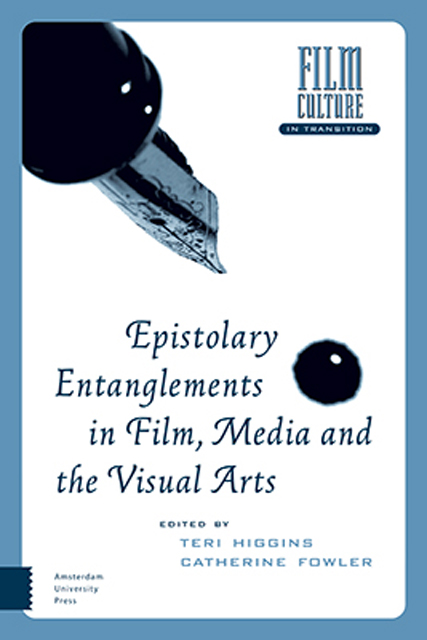Book contents
- Frontmatter
- Table of Contents
- Acknowledgements
- Doing (Audio-Visual) Things with Words – From Epistolary Intent to Epistolary Entanglements: An Introduction
- 1 Performance and Power : The Letter as an Expression of Masculinity in Game of Thrones
- 2 ‘My dearest little girl, I just got your letter and I hope that you will continue to write to me often’: Epistolary Listening in News from Home (Chantal Akerman, 1976)
- 3 Dead Letters: Epistolary Hauntology and the Speed of Light in Personal Shopper (Olivier Assayas, 2016)
- 4 Attention to Detail: Epistolary Forms in New Melodrama
- 5 The Spiritual Intimacies of The Red Hand Files: How Long Will I Be Alone?
- 6 Video Authenticity and Epistolary Self-Expression in Letter to America (Kira Muratova, 1999)
- 7 Epistolary Affect and Romance Scams: Letter from an Unknown Woman
- 8 Delivering Posthumous Messages : Katherine Mansfield and Letters in the Literary Biopic Leave All Fair (John Reid, 1985)
- 9 The Interactive Letter : Co-Authorship and Interactive Media in Emily Short’s First Draft of the Revolution
- 10 Epistolary Distance and Reciprocity in José Luis Guerín and Jonas Mekas’s Filmed Correspondences
- 11 Instagram and the Diary : The Case of Amalia Ulman’s Excellences & Perfections (2014)
- 12 Civil War Epistolary and the Hollywood War Film
- 13 Epistolarity and Decolonial Aesthetics in Carola Grahn’s Look Who’s Talking (2016)
- 14 Epistolary Relays in Fatih Akin’s Auf der anderen Seite (On the Other Side/On the Edge of Heaven) (2007)
- Index
Doing (Audio-Visual) Things with Words – From Epistolary Intent to Epistolary Entanglements: An Introduction
Published online by Cambridge University Press: 20 June 2023
- Frontmatter
- Table of Contents
- Acknowledgements
- Doing (Audio-Visual) Things with Words – From Epistolary Intent to Epistolary Entanglements: An Introduction
- 1 Performance and Power : The Letter as an Expression of Masculinity in Game of Thrones
- 2 ‘My dearest little girl, I just got your letter and I hope that you will continue to write to me often’: Epistolary Listening in News from Home (Chantal Akerman, 1976)
- 3 Dead Letters: Epistolary Hauntology and the Speed of Light in Personal Shopper (Olivier Assayas, 2016)
- 4 Attention to Detail: Epistolary Forms in New Melodrama
- 5 The Spiritual Intimacies of The Red Hand Files: How Long Will I Be Alone?
- 6 Video Authenticity and Epistolary Self-Expression in Letter to America (Kira Muratova, 1999)
- 7 Epistolary Affect and Romance Scams: Letter from an Unknown Woman
- 8 Delivering Posthumous Messages : Katherine Mansfield and Letters in the Literary Biopic Leave All Fair (John Reid, 1985)
- 9 The Interactive Letter : Co-Authorship and Interactive Media in Emily Short’s First Draft of the Revolution
- 10 Epistolary Distance and Reciprocity in José Luis Guerín and Jonas Mekas’s Filmed Correspondences
- 11 Instagram and the Diary : The Case of Amalia Ulman’s Excellences & Perfections (2014)
- 12 Civil War Epistolary and the Hollywood War Film
- 13 Epistolarity and Decolonial Aesthetics in Carola Grahn’s Look Who’s Talking (2016)
- 14 Epistolary Relays in Fatih Akin’s Auf der anderen Seite (On the Other Side/On the Edge of Heaven) (2007)
- Index
Summary
Abstract
In this introduction we outline the notion of epistolary intent through which, we argue, the textual adds to and disrupts the audio-visual in particular ways. We also explain the use of the term ‘entanglements’ to encapsulate the disruptive nature of epistolary forms on screen. As a meshed shape for communication and intra-active exchange, entanglement describes complicated situations. We isolate three examples of epistolary disruption – with narratives, genres, and the audio-visual – in order to pin-point the intervention this book makes into existing scholarship. Finally, we outline the structure of the collection through summaries of the fourteen chapters.
Keywords: epistolary intent; epistolary entanglement; intimacy; romance; testimony
A Great Epistolary Age
We are living in a great epistolary age, even if no one acknowledges it. Our phones, by obviating phoning, have reestablished the omnipresence of text. Think of the sheer profusion of messages […] that we now send.
As novelist Sally Rooney observes, sending a message to someone who is absent from us is a familiar part of our everyday lives in the twenty-first century, hence, we have all become writers in one form or another. Text has become intricately woven into our lives and plays an intimate part in the way we build relationships, therefore writing has inevitably found its way into screen narratives in the form of text messages and emails, sent and received. This collection is conceived as a response to the ‘omnipresence of text’ on screen and it explores how the visual/textual texture of screen media is changing. First, it argues that contemporary online forms of communication such as the email, blog, text message, tweet, are actually haunted by older epistolary forms such as the letter and the diary. Second, it examines what is at stake for our understanding of the self when it communicates through epistolary forms.
By accounting for the ‘omnipresence of text’ across a variety of media, this collection intervenes in debates about how the textual adds to and/ or disrupts the audio-visual. On-screen epistolary forms adopt a number of different shapes. In mainstream cinema and television series epistolary forms have become narrational and plot devices. They operate as correspondence between characters who write messages, communicate, and form relationships. In less mainstream films and media epistolary forms often contend with an injunction.
- Type
- Chapter
- Information
- Publisher: Amsterdam University PressPrint publication year: 2023



